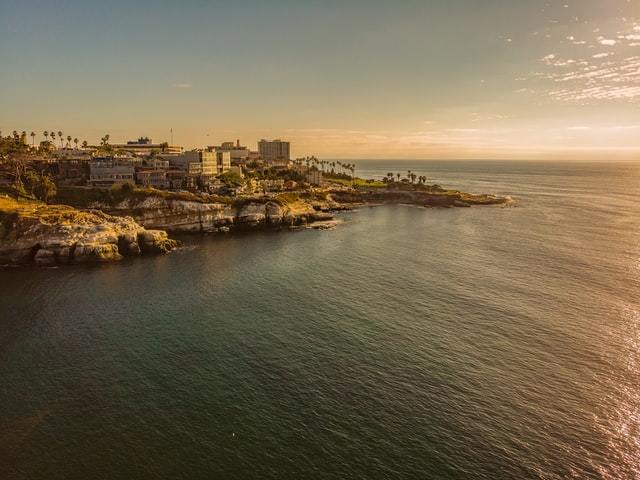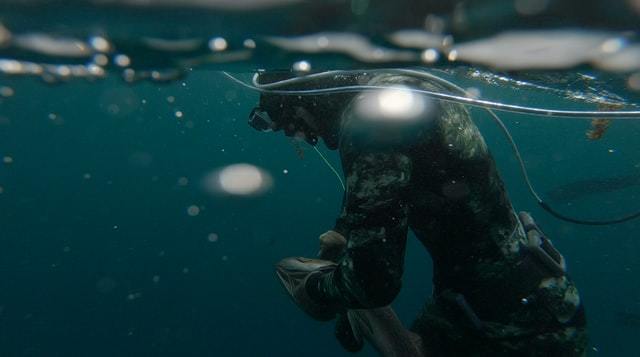The combination of freediving and spearfishing is a wonderful way to feel more alive in the water and feel closer to nature. And when spearfishing in San Diego and elsewhere in California it is even more so...
Because your time under water is limited to how long you can hold your breath, learning to spearfish is second to learning to safely freedive.
However, once you are comfortable as a diver, spearfishing will bring you back to the water again and again - and that will bring you to San Diego and California.
Jump right into our location guide to learn about Spearfishing and Freediving in California.

Freediving Locations Around San Diego and Elsewhere in California
La Jolla Cove
One of the nicest things about spending time diving at La Jolla Cove, one of the best freediving spots in California, is that you can walk to your chosen dive site. You don't have to rent a boat to enjoy time in these clear waters, and the place is alive with Garibaldi fish.
Turtle Town
This diving treat for anyone interested in freediving San Diego is in the center of the marine sanctuary just offshore from the city. You will need to work to get into this region of water, and you obviously can't use any spearing equipment. However, this stretch of water is loaded with sea turtles and colorful fish; a joyful place to dive!
Sonoma County
In Northern California, freedivers are working both to enjoy the water and clean up the region where pollution is most problematic. Those with an interest in preserving and freediving California may be interested in abalone. Abalone divers will enjoy South Cove off of Salt Point State Park. Be aware that you can only take 18 abalone per calendar year and the penalties are stiff. Additionally, rough seas mean that visibility here can be pretty tough.
Gerstle Cove
Gerstle Cove is a protected area that is also off of Salt Point State Park and ideally suited for non-hunting divers. It will take some skills to get to this cove as the hiking can be challenging. However, once you reach this cove, the natural barriers make it easy to enjoy the natural beauty of the sea life that shelters here. Do be aware that there are shipwrecks in the area that make for great diving, but the water is quite cold and there is a chance of rip tides.

La Jolla beach - A beautiful spot for freediving in California
Common Fish Species to Target for Spearfishermen in California
California has very specific rules about
To start, your daily limit is just twenty fish.
More than that and you risk a fine, gear confiscation and loss of your fish.
Additionally, no matter what species you are hunting for, you can't take more than ten of any species.
Know what you're aiming at and put in the time to learn to judge length and weight to avoid facing a penalty.
For beginning spearfishermen, staying in shallow waters and going for smaller fish is the best plan. While your limit in a yellowfin tuna is more than 80 pounds, you don't want to start with something that big. It's also a good idea to start with a fish that is easy to clean if you are spearfishing for food.
Pacific Bonito
The Pacific Bonito, or sarda chiliensis, are generally found within the first 15 miles of coastal waters. These fish are abundant and fast growing, featuring slanting stripes on their backs for easy identification. They migrate in when the water warms and are great eating fish. Bleed them shortly after capture and keep them cool.
California Halibut
If you love to dive all the way to the bottom, keep an eye out for the California Halibut, or the Paralichthys californicus. This fish lingers at the bottom but likes to be near structures. You can generally find them at no deeper than 180 feet. The top is brown and blotchy while the bottom is white and the teeth are sharp, so be careful.
Opaleye
The Opaleye, or Girella nigricans, likes to stay under the kelp canopy and near the rocker shores. They don't care to go too deep, making them a terrific fish for those new to spearfishing. They also tend to follow the tide. If you're diving off Baja, there may be more spots on the back of this fish than those that stay in cooler northern coastal waters.
When studying what fish to start with, take care to consider the possible age of the fish you're hunting. The Bonito is a fast-growing, short-lived fish.
The California Sheephead on the other hand can grow to 40 pounds, but it can take more than 50 years to get there.
Spearfishing is the most selective, most sustainable and the least destructive fishing method there is but only if we practice it correctly and use our common sense.

Spearfishing Locations around San Diego and Elsewhere in California
Some of the best spearfishing southern California offers is off of Catalina Island and the most popular fish to go after hear is the yellowtail tuna.
The fishing off of Catalina is quite rocky and the yellowtail are wary, so you'll need to be extremely comfortable with your spearfishing gear and confident in your diving prowess. However, getting to 70 feet deep and finding one of these fish is worth the time it will take to get your lungs in shape.
Kelp forests make for terrific spearfishing spots California. The coasts from Long Beach to Newport Beach offer easy access to these kelp forests and you can easily spear tuna and mahi mahi in summer and early fall. Cooler seasons feature seabass and rockfish.
If you can hire a boat to take you out a bit deeper or for an overnight, you can head out to San Clemente and go for some bigger fish in deeper water. Of all the spearfishing locations California offers, these deeper waters will bring even more of a challenge. Marlin, barracuda and even albacore tuna are an option for more skilled spearfishermen.
For less experienced spearfishers who are just getting started, there are still plenty of options. You can get in the water right off the docks of San Diego and enjoy time in miles of kelp forests in La Jolla and Point Loma. When you're just starting out, these spearfishing locations San Diego will give you access to halibut, rockfish, calico bass and yellowfin.
Spearfishing Regulations in San Diego & California
If you plan to go Spearfishing California, consider getting a freshwater license and ocean stamp, which will allow you more options.
Do be aware that your location will be limited as there are restricted areas if you plan to go Spearfishing in San Diego.
Finally, if you choose to go out in a boat, be aware that the only gear you can have in the boat when using your spearfishing license is spearfishing gear. No rods, reels, or any other topside gear can be brought with you. Make sure you also carry your spearfishing license in a waterproof pouch and keep it with you.
One you've familiarized yourself on the spearfishing regulations California imposes on your freediving adventure, you'll be ready to find a location.
There are a lot of spearfishing spots San Diego features, but many of them get pretty deep. For beginners, getting started in freshwater may be the safest step. Once you have your diving skills honed, you can head for deeper waters.
Building Both Skills and Gear
Your first few rounds of freediving should be all about the long fins. If you're swimming skills are already strong, you need to develop a fast way to get deep and get back the the surface in confidence before you ever pick up any spearfishing gear.
Your fitness level, swimming skills, and ability to stay calm under pressure can all impact your success as a freediver. For best results, try not to get additional gear until you've built up strong skills at your current level of freediving. With the right guide, you can actually freedive with very little gear depending on water temperature and visibility.
To dive, start with
- a low-volume mask
- fins of your choice, either long-blade or monofin
Working effective in a monofin takes practice. The kicking method of working both feet at once can feel quite cumbersome and may lead to anxiety. If you have fin experience as a scuba diver, you may feel more comfortable in long-bladed fins to increase your speed without having to work both feet at once.
Once you're ready for colder, deeper waters, a wetsuit and spearfishing gear can be added to your list. This gear includes
Training with a skilled spearfishing professional is key to learning to do this safely. A speargun will pierce whatever tissue you put in front of it, including your fishing partner. Start with safety training before you spend too much on gear.
Once you have a great wetsuit and are ready to get into the water, freediving and spearfishing opportunities abound. Do make sure to build strong swimming skills.
Never go spearfishing alone or with anyone who doesn't respect the gear and safety rules; it's just as easy to get shot as to shoot with a novice or careless spearo.
However, the right water and clan can make the art of freediving and the skill of spearfishing a great way to celebrate being in the water.


